Ortho (legacy)
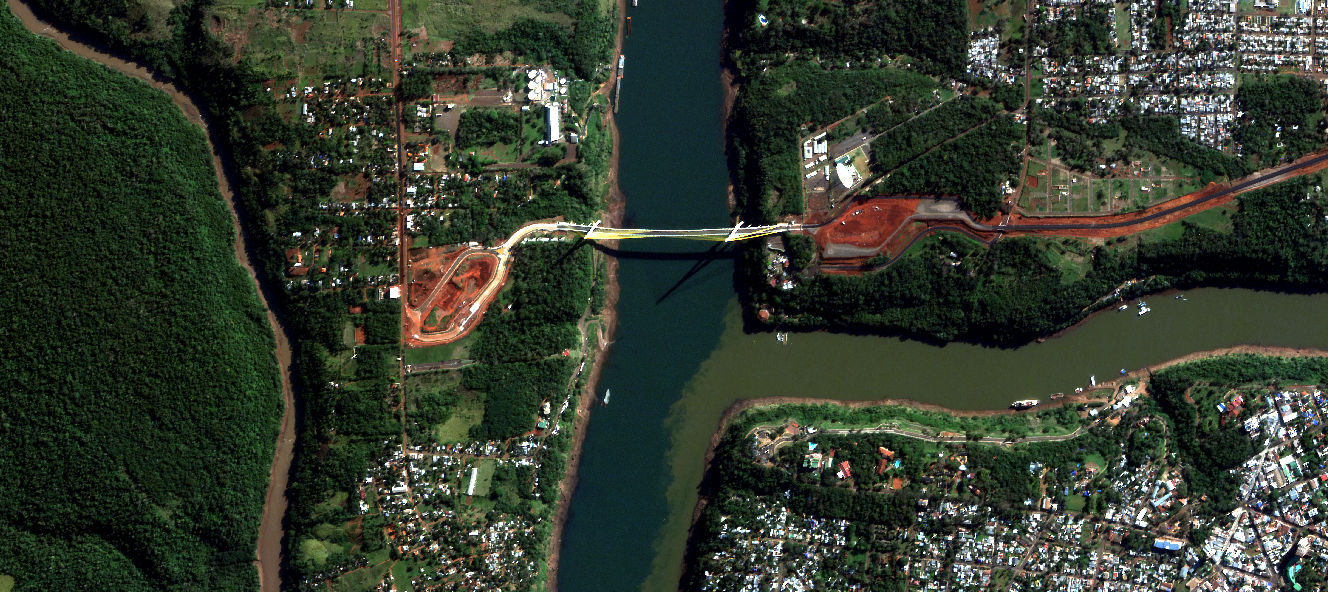
Product description
The L1D and L1D_SR imagery products are 4-band (RGB and Near infrared) product designed for accuracy and best of class image quality. It is delivered to customers after going through radiometric and geometric correction process.
The current delivery package structure that is presented in the next sections will be replaced by the one presented in Ortho (L1D/L1D_SR) starting from 1 October 2024. The list of changes can be found in the product changelog.
Technical Specifications
| Parameter | Mark IV |
Mark V |
|
|---|---|---|---|
| Sepctral bands | Blue : 450 - 510 nm |
Blue : 450 - 517 nm |
|
| GSD | 1m (L1) / 0.7m for (L1_SR) |
0.7m (L1) / 0.5m (L1_SR) |
|
| Scene Swath | 4.8 - 5.5 Km 1 |
6.8Km - 8.5Km 1 |
|
| Image bit depth | 8-bit for VISUAL, 16 bit for TOA |
| |
| Max Off-Nadir angle | ± 25 deg |
| |
| Algorithms applied | Radiometric correction, Band Aligment, Fine geolocation, Projection to UTM and orthorection |
| |
| Geolocation Accuracy | 10m CE90 Varies with the availabilty of GCPs and cloud coverage2 |
| |
| Band aligment | <= 2pxTBD |
| |
| Image format | GeoTiff, LZW loseless compression |
| |
| Ancilliary files | Cloud mask (GeoTiff), preview (PNG), thumbnail (PNG) and imagery footprint in vector format. |
| |
| Metadata | STAC metadata, ISO metadata, TOA factors and solar and viewing angles |
| |
Product presentation
The ortho products are currently offered in two major processing levels:
- L1 TOA Reflectance (L1)
- L1 TOA Reflectance SuperResolution (L1_SR)
L1, is a 4 bands (blue, green, read and Near Infrared) imagery product with Top of the Atmosphere reflectance records measurements in physical units, and enables analysts to perform basic classifications and analytics. The imagery is radiometrically and geometrically corrected. Pixel values are scaled to TOA Reflectance (0 to 1) multiplied by a factor 10000 (1e4) to avoid float numbers. L1 TOA has a resolution of 1m after resampling, which harmonises native pixel size that varies between 0.7m and 1.3m.
L1_SR_, goes through one step further in processing which applies proprietary super resolution algorithm to improve the Ground Sample Distance (GSD) from 1m to 70 cm for Mark IV satellites and from 70cm to 50cm for Mark V satellites.
Both L1 and L1_SR products are currently delivered along with a corresponding VISUAL Products called L3 and L3 SR. This is a 3 bands imagery (red, green and blue), with color enhancement algorithm (histogram stretching) has been applied to enhance the visual quality of the image.
The figure below illustrates the high level image processing workflow, which begins upon receiving raw data and is completed after the transfer of processed data to the image catalog and product delivery package:
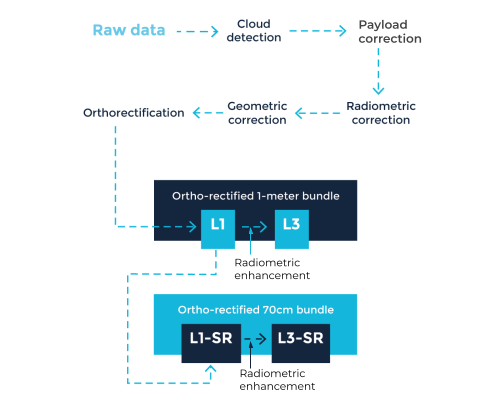
For geometric and radiometric processing details please refer to Image processing section.
Product framing
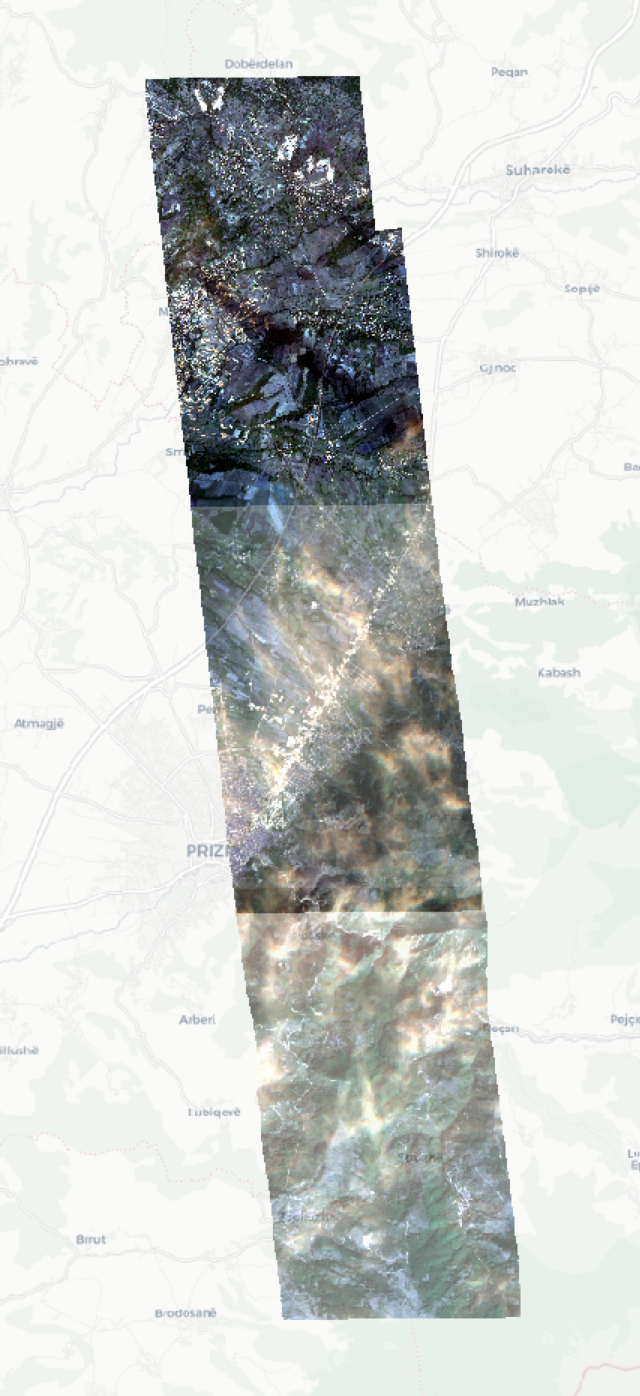
Ortho products are currently packaged as entire scenes. Each scene is a full swath (approximately 5Km) image with a varying length depending on the capture or requiered area by the user. In case the of very big scenes, the scene is divided into 10km chunks and identified with a chunk number indicated at the end of the file name starting from 0. Also the provided VRT merges all these chunks for easier manipulation.
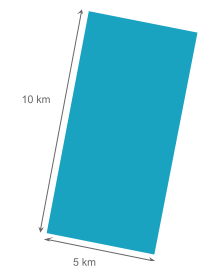
For example, a long scene is shown on the right that has been automatically "chunked" into 3 ~10Km chunks. Colors and transparency had been modified to show the concept.
Projection
Each ortho scene is projected to the corresponding projection according to their closest matching UTM Zone. The projection is indicated in the proj:epsg property of each product metadata. If a scene is captured across different zones, the entire scene and corresponding chunk are projected to the zone with more data.
Product Package content
The file name as displayed below follows this format:
<DATE>_<TIME>_SN<SATELLITE_NUMBER>_<L1/L1_SR>_<TASK_ID>
The date is in UTC time observed at the centre of image, the product level correspond to the level of processing. For example, “L1”=Reflectance (TOA) 4 Bands, “L3”=TOA RGB, and “SR”=SuperResolution (depending on order), the payload indicates whether the product is multispectral (MS) of hyperspectral (HS). HS product is not yet commercialised at this moment.
The folder structure is displayed below, just open the dropdowm and see the delivery folder content which including metadata and different raster formats including the light weight virtual rasters as well as image previews.
<DATE>_<TIME>_SN<SATELLITE_NUMBER>_L1_SR_MS_<TASK_ID>
├── <DATE>_<TIME>_SN<SATELLITE_NUMBER>_L1_SR_MS.vrt
├── <DATE>_<TIME>_SN<SATELLITE_NUMBER>_L1_SR_MS_cloud_mask.vrt
├── <DATE>_<TIME>_SN<SATELLITE_NUMBER>_L1_SR_MS_footprint.kml
├── <DATE>_<TIME>_SN<SATELLITE_NUMBER>_L1_SR_MS_metadata_iso.xml
├── <DATE>_<TIME>_SN<SATELLITE_NUMBER>_L1_SR_MS_metadata_stac.geojson
├── <DATE>_<TIME>_SN<SATELLITE_NUMBER>_L1_SR_MS_solar_and_viewing_angles.geojson
├── <DATE>_<TIME>_SN<SATELLITE_NUMBER>_L1_SR_MS_toa_factors.json
├── <DATE>_<TIME>_SN<SATELLITE_NUMBER>_L3_SR_MS.vrt
├── <DATE>_<TIME>_SN<SATELLITE_NUMBER>_L3_SR_MS_preview.png
├── <DATE>_<TIME>_SN<SATELLITE_NUMBER>_L3_SR_MS_thumbnail.png
└── rasters
├── <DATE>_<TIME>_SN<SATELLITE_NUMBER>_L1_SR_MS_<N>.tif
├── <DATE>_<TIME>_SN<SATELLITE_NUMBER>_L1_SR_MS_cloud_mask_<N>.tif
├── <DATE>_<TIME>_SN<SATELLITE_NUMBER>_L3_SR_MS_<N>.tif
| File | Description |
|---|---|
| *_L1_SR_MS.vrt | A GDAL Virtual raster that contains all the corresponding TOA TIFs in the rasters folder. In case of very big images, mutliple tifs can be included in the package. |
| *_L1_SR_cloud_mask.vrt | A GDAL Virtual raster that contains all the corresponding cloud masks TIFs in the rasters folder. In case of very big images, mutliple tifs can be included in the package. |
| *_L1_SR_MS_footprint.kml | The overal raster ground footprint in KML |
| *_L1_SR_MS_metadata_iso.xml | A Metadata file in ISO 19115-2 format containing the key information from the metadata of the product. See the metada section for more information. |
| *_L1_SR_MS_metadata_stac.geojson | A Metadata file in STAC format containing the aggregated information of the product. See the metada section for more information. |
| *_L1_SR_MS_toa_factors.geojson | A Geojson file that contains the coefficients to transform the TOA product into Radiance units. |
| *_L1_SR_MS_solar_and_viewing_angles.geojson | A Geojson file that contains extra metadata about the sun and viewing angles. |
| *_L3_SR_MS.vrt | A GDAL Virtual raster that contains all the corresponding VISUAL L3 TIFs in the rasters folder. In case of very big images, mutliple tifs can be included in the package. |
| *_L3_SR_MS_preview.png | The preview component of the product for the entire scene |
| *_L3_SR_MS_thumbnail.png | A low resolution thumbnail of the scene |
| rasters/*L1_SR_MS |
The full resolution TOA raster that comprises the full scene. For very large captures, the rasters are divided into smaller chinks. The number |
| rasters/*L3_SR_MS |
The full resolution VISUAL raster that comprises the full scene. For very large captures, the rasters are divided into smaller chinks. The number |
| rasters/*L1_SR_MS_cloud_mask |
The cloud mask raster files |
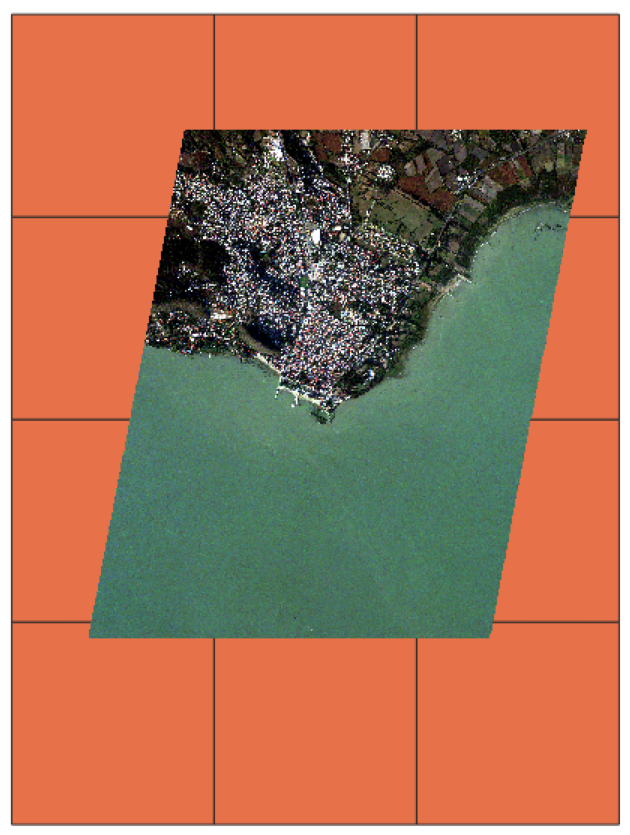
The *_toa_factors.geojson file contains the coefficients for converting the DNs into Radiance and Reflectance units respectively as a geojson tiled file on a grid of 4x4 km2 tiles. The image on the right depicts this file overlaid with the raster file for reference. Small variation of the radiance coefficients can be expected across the image.
The *_solar_and_viewing_angles.geojson file contains the solar elevation and azimuth angles, earth/sun distance, satellite azimuth, zenith and altitude as well as ground elevation and their unit of measurmeent in a tiled fashion as shown for the *_toa_factors.geojson file.
Metadata
ISO 19115-2 Metadata
Satellogic adheres to industry standards governing metadata schemas that align with ISO standards. The adoption of ISO 19115 (ISO metadata standard) ensures that information about sensor identification, image extent, quality, spatial and temporal aspects, content, spatial references, distributions, and other properties of digital geographic data are provided in a XML format for customers seeking to integrate Satellogic map-ready orthorectified raster data directly into their workflows. The table below shows the metadata fields according to ISO 19115-2:
| Identifier | Type | Description |
|---|---|---|
| gmd:fileIdentifier | string | Unique file identifier |
| gmd:language | code | Language used for metadata (eng) |
| gmd:characterSet | code | Character coding standard in the metadata (utf8) |
| gmd:contact | string | Contact information of the company responsible for the metadata information (Satellogic) |
| gmd:dateStamp | date | Date of dataset creation in UTC |
| gmd:metadataStandardName | string | Name of the metadata standard used (ISO) |
| gmd:metadataStandardVersion | string | ISO metadata standard version |
| Spatial Representation Information: Grid Spatial Representation | ||
| gmd:numberOfDimensions | integer | Number of independent spatial-temporal axes (2d: x, y ) |
| gmd:axisDimensionProperties | string/integer | Dimension name (column) and size (integer), resolution (m) |
| gmd:cellGeometry | code | Grid data identification (area) |
| gmd:transformationParameterAvailability | boolean | Dataset coordinates and geographic or map coordinates availability |
| gmd:referenceSystemInfo | string/date | Information of CRS provider, release date, version and edition details |
| Metadata extension information | ||
| gmd:extensionOnLineResource | string | Internet location (address) for on-line access |
| gmd:MD_ExtendedElementInformation | string | Exposure time (seconds) and responsible party information (Satellogic) |
| Data Identification | ||
| gmd:abstract | string | Scene set identification (Scene set ID) |
| gmd:pointOfContact | string | Contact information |
| gmd:resourceMaintenance | string | Information on dataset maintenance |
| gmd:resourceConstraints | string | The limitations or constraints on the use of or access to dataset |
| gmd:spatialRepresentationType | code | Object used to represent the geographic information |
| gmd:language | code | Languages of the dataset using standard ISO three letter codes (eng) |
| gmd:characterSet | code | Character coding standard in the dataset |
| gmd:environmentDescription | string | Describes the dataset’s processing environment |
| gmd:extent | decimal | Information about geographic extent of the dataset (bounding box coordinates) |
| Supplemental information | ||
| Satellite Number | string | Satellogic satellite number |
| Satellite Name | string | Satellogic satellite name |
| gmd:contentInfo | string | Sensor type, dataset content type |
| gmd:dimension | string | Imagery bands information (name and wavelength) |
| gmd:illuminationElevationAngle | decimal | Sun elevation angle in degrees |
| gmd:illuminationAzimuthAngle | decimal | Sun azimuth angle in degrees |
| gmd:imageQualityCode | string/date | Metadata standard and version release |
| gmd:cloudCoverPercentage | decimal | Percentage of the are covered by clouds |
| gmd:processingLevelCode | string | Corresponds to data product level |
| gmd:compressionGenerationQuantity | integer | Compression information |
| gmd:distributionFormat | string | Dataset format name and version |
STAC Metadata
STAC metadata have all required STAC items by their schema, in addition they contain the following properties:
| Item | Type | Properties |
|---|---|---|
| Properties | ||
| title | string | The title describing the dataset |
| description | string | Scene set identification (scene set id) |
| datetime | string | The date and time of the dataset acquisition, in UTC |
| created | date | Creation date and time of the corresponding dataset package, in UTC |
| license | string | Dataset license (current: confidential, next metadata release: proprietary) |
| providers | object | Dataset providers name, description, roles and contact details (Satellogic) |
| platform | string | Unique name of the specific platform to which the instrument is attached (NewSat) |
| instruments | string | Name of instrument or sensor used (MS) |
| constellation | string | Name of the constellation to which the platform belongs (Aleph1) |
| gsd | [number] | Ground Sample Distance at the sensor, in meters (1m for L1 and 70cm for L1-SR) - for next metadata release |
| eo:cloud cover | [number] | Estimate of cloud cover, in percentage |
| proj:epsg | string | EPSG code of the dataset projection |
| proj:centroid | [number] | Coordinates of the center point of the dataset in latitude/longitude |
| view:sun_elevation | [number] | Sun elevation angle, in degrees |
| view:off_nadir | [number] | The angle from the sensor between nadir (straight down) and the scene center, in degrees |
| satl:exposure_sec | [number] | Sensor exposure time to light, in seconds |
| satl_type | string | Type of dataset (i.e. acquisition mode) |
| satl:sat_id | string | Unique identification of the Satellite |
| satl:product_level | string | Product processing level properties |
Imagery End User Rights Agreement and Terms of Use
All imagery products are delivered under Satellogic Imagery End User License Agreement. The terms and conditions of the agreement are available to customers and accessible online on the website under License Agreement.
Cloud masks
The end product provided by Satellogic also includes cloud masks (see section: Product Package content). The mask is a single band GeoTiff for each delivered chunk. The values of the raster represent different cloud data as follows:
0: nodata 1: valid_data 128: cloud
The current cloud detector is able to detect "thick" clouds i.e. clouds that do not allow to view the content of the image below them or only a minimal part of it. Currently haze is therefore not labelled as cloud. An example is provided in the next image.

[0.3.0] 2024-07-12
Changed - Change higher percentile in histogram stretching of L3 product to deal with saturation on bright objects
[0.2.0] 2024-04-29
Fixed - Fix Stray light correction for MarkV imagery
Added - Improve sharpness for MarkV imagery
Changed - Change DN conversion to 10 bits
[0.1.0] 2024-04-03
Added - Post to new archive 2.0 L1D and L1D-SR products